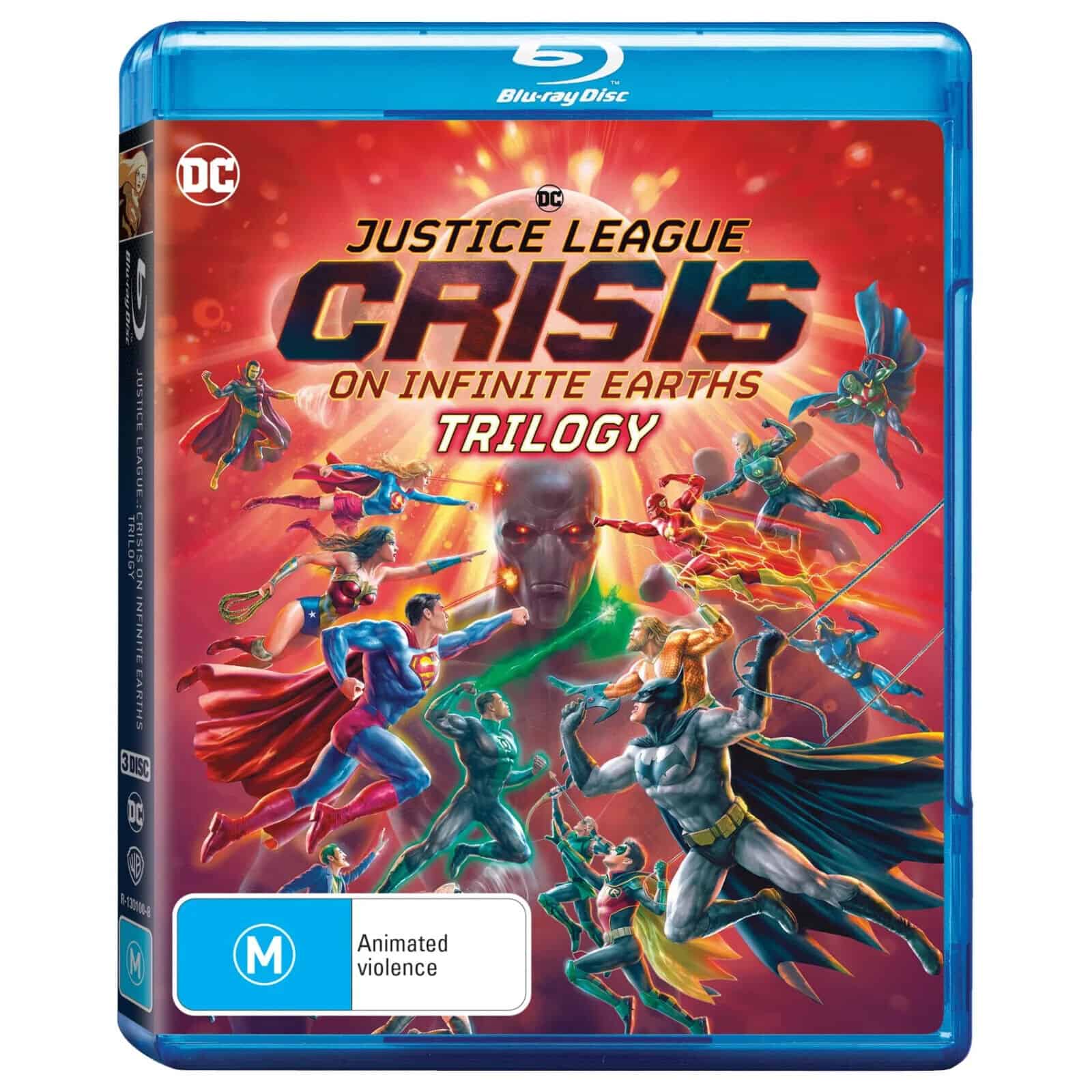The DC Universe has tackled “Crisis on Infinite Earths” twice now—once in live-action as a bold crossover event in the CW’s Arrowverse, and more recently as a three-part animated film trilogy that concludes the Tomorrowverse storyline. While the CW version made headlines for its sheer scope and TV crossover novelty, the animated trilogy aims to bring the original comic’s sprawling, cataclysmic vision to life with far greater fidelity—and mixed success.
Let’s break down what the animated trilogy got right, where it faltered, and how it compares to its predecessors in both style and substance.
What Worked: Faithfulness to the Source and Ambition
At its best, the Justice League: Crisis on Infinite Earths trilogy feels like a love letter to one of the most iconic events in comic book history. The original 1985-1986 comic series by Marv Wolfman and George Pérez was groundbreaking—it condensed decades of continuity into a cohesive, rebooted universe. The animated films don’t shy away from replicating that ambition, blending heroes, timelines, and earths in a chaotic but visually ambitious storyline.
Part One sets a strong tone, focusing on Barry Allen and how his sacrifice echoes the character-defining moment from the comics. It’s rich in emotional weight, with high-quality animation and surprisingly nuanced character arcs for an ensemble cast. Notably, the art style—consistent with the Tomorrowverse’s previous films like Superman: Man of Tomorrow and Justice Society: World War II—delivers crisp action scenes that elevate key moments, particularly the death of Supergirl and Barry’s run into oblivion.
What Didn’t Work: Inconsistent Pacing and a Disappointing Payoff
While Part One was praised (88% on Rotten Tomatoes), the second and third installments didn’t maintain the same momentum. Part Two struggled with pacing and character bloat. Many fans and critics noted that emotional beats were sacrificed for exposition-heavy sequences that didn’t land. On Rotten Tomatoes, Part Two nosedived with a 17% rating—an unusually sharp decline for a DC animated film.
Part Three, meant to be the emotional and narrative climax, did little to recover. While it includes a beautifully executed farewell to Kevin Conroy’s Batman—his final performance before his passing in 2022—it also feels rushed and overloaded. The multiverse destruction feels oddly impersonal, and the attempt to unify the timelines into a reborn Earth lacks the impact it should’ve had. The 20% Rotten Tomatoes rating reflects this disappointment.
Comparing to the CW Crossover
The CW’s 2019-2020 “Crisis on Infinite Earths” event was undeniably clunky in places, but it pulled off something no other TV event had dared to do. Spanning Supergirl, Batwoman, The Flash, Arrow, and Legends of Tomorrow, it brought in cameos from both the Arrowverse and beyond—Tom Welling’s Clark Kent (Smallville), Burt Ward’s Robin (Batman ‘66), and even Ezra Miller’s Flash from the DCEU films made appearances.
The animated trilogy doesn’t quite match that meta-magic, but it does achieve something else: it tells a more cohesive, canon-resetting story. Where the CW version celebrated fan service and legacy, the animated version is more focused on reshaping the continuity for future films—likely setting the stage for DC’s next animated continuity.
Kevin Conroy’s Batman: A Fitting Tribute
One undeniable highlight is the inclusion of Kevin Conroy, who reprises his role as Batman one final time. Having voiced the character since Batman: The Animated Series in the 1990s, Conroy’s voice is synonymous with the Dark Knight for multiple generations. His scenes in Part Three, though brief, are poignant and powerful—closing the chapter on both his legacy and the Tomorrowverse.
Final Take
The Crisis on Infinite Earths animated trilogy is a bold experiment. It brings weighty themes of sacrifice, legacy, and rebirth to animation, and at times, it genuinely soars. But its flaws—especially in Parts Two and Three—make the overall trilogy feel uneven.
Still, it’s worth watching for DC fans. Whether you’re there to witness the end of the Tomorrowverse, to see Conroy’s final bow, or to relive one of comics’ most epic events in animated form, there’s a lot here to appreciate—even if it didn’t stick the landing.
If DC continues to adapt its biggest events in animation, the hope is that they learn from this trilogy: aim high, yes—but don’t forget that heart and pacing matter just as much as spectacle.
Key Takeaways
- “Crisis on Infinite Earths” should be watched in a specific five-episode order across different CW shows for the complete story.
- The crossover permanently altered the Arrowverse continuity and brought together heroes from multiple DC television properties.
- Similar to its comic book inspiration, the television adaptation served as a pivotal moment that reshaped storylines and character relationships.
Crisis on Infinite Earths Overview
Crisis on Infinite Earths stands as one of the most significant events in DC Comics history, reshaping the entire multiverse and impacting decades of storytelling across comics, television, and film adaptations. The epic crossover fundamentally altered how superhero narratives approach continuity and parallel universes.
Background and Publication History
Crisis on Infinite Earths was published by DC Comics from 1985 to 1986 as a 12-issue limited series. Written by Marv Wolfman and illustrated by George Pérez, the series emerged as DC’s solution to decades of complicated continuity problems.
By the 1980s, DC’s multiverse had become increasingly complex with numerous parallel Earths (Earth-One, Earth-Two, Earth-X, etc.). This complexity made storylines difficult for new readers to follow. Editorial director Dick Giordano and editor Jenette Kahn approved the Crisis project to streamline continuity.
The series was revolutionary for its time, introducing the concept of a company-wide crossover event that would affect every title in DC’s publishing line. This publication model became the template for future major comic events across the industry.
Key Storylines and Events
The Crisis narrative centers on a cosmic entity called the Anti-Monitor attempting to destroy the multiverse, while his counterpart, the Monitor, recruits heroes from various Earths to fight back. The story spans billions of years and countless realities.
Key moments include:
- The death of Supergirl in issue #7, sacrificing herself to save Superman
- The Flash (Barry Allen) dying while destroying the Anti-Monitor’s antimatter cannon
- The merging of five surviving Earths into a single new Earth with a consolidated timeline
- The final battle against the Anti-Monitor at the dawn of time
The crossover featured virtually every DC character published to that point. Cosmic entities like Spectre and Darkseid played crucial roles alongside mainstream heroes like Superman, Batman, and Wonder Woman.
Crossover Implications and Legacy
Crisis permanently altered DC’s fictional universe, establishing a single Earth with one consistent history. Many characters were rebooted or reimagined in its aftermath.
The Crisis concept later inspired the Arrowverse television crossover of the same name spanning five shows: Arrow, The Flash, Supergirl, Batwoman, and Legends of Tomorrow. This adaptation brought the comic’s multiverse concept to television audiences.
The story established a template for reality-altering “crisis” events in comics. DC has revisited the format with subsequent crossovers like Infinite Crisis, Final Crisis, and Flashpoint. In 2020, DC published “Dark Nights: Death Metal,” which reestablished a new version of the DC multiverse.
The concept remains influential in current DC projects, including the animated Justice League: Crisis on Infinite Earths film trilogy that began releasing in 2024, demonstrating the enduring legacy of this watershed storytelling event.
Impact on DC Universe and Adaptations
Crisis on Infinite Earths fundamentally changed DC Comics storytelling and has influenced multiple adaptations across television and film. The event’s ripple effects continue to shape the DC multiverse today.
Alterations to Character Histories and the Universe
Crisis on Infinite Earths radically simplified DC’s continuity by merging multiple parallel worlds into one cohesive universe. Before the Crisis, characters like Superman and Batman existed across multiple Earths with different histories and versions.
The event eliminated many duplicate characters and streamlined origin stories. Superman’s history was completely rewritten by John Byrne. Wonder Woman received a new beginning as a hero who arrived in “Man’s World” after the Crisis rather than during World War II.
The Justice Society of America, once residents of Earth-2, were repositioned as heroes from an earlier generation on the single Earth. This allowed for mentorship dynamics between older heroes and their successors.
Some characters, like The Flash (Barry Allen) and Supergirl, died during the Crisis—though both would eventually return years later through subsequent reality-altering events like Flashpoint.
Television Adaptation and Its Influence
The Arrowverse’s adaptation of “Crisis on Infinite Earths” became television’s most ambitious superhero crossover. Spanning five shows—Arrow, The Flash, Supergirl, Batwoman, and Legends of Tomorrow—it connected DC properties across multiple networks and decades.
Unlike the comics, the TV version centered on Oliver Queen/Green Arrow as a key figure in saving the multiverse. The Arrowverse Crisis featured cameos from properties previously thought unconnected, including the 1990s Flash series, Smallville, and even the DCEU’s Flash.
The animated “Tomorrowverse” also adapted Crisis, focusing more closely on Justice League heroes like Batman, Superman, and Wonder Woman while still maintaining the core concept of fighting to save reality.
Both adaptations used the Crisis framework to reset continuity. The Arrowverse version merged Supergirl’s Earth with The Flash’s, while creating a new multiverse structure that allowed for future storytelling flexibility.
Frequently Asked Questions
Crisis on Infinite Earths sparked many questions among fans due to its complex storyline across multiple shows and its significant impact on the DC television universe. Here are answers to some of the most common questions about this epic crossover event.
What is the correct viewing order for the Crisis on Infinite Earths episodes?
The correct viewing order for Crisis on Infinite Earths follows the numbered parts across different series. Start with Supergirl (Part 1), then Batwoman (Part 2), followed by The Flash (Part 3). The event concludes with Arrow (Part 4) and DC’s Legends of Tomorrow (Part 5).
This order ensures viewers experience the story as intended, with each episode building upon the previous one’s events. The crossover was designed to be watched in this sequence regardless of whether viewers followed all the individual shows.
Are all parts of Crisis on Infinite Earths contained within one series, or are they spread across multiple series?
Crisis on Infinite Earths spans five different Arrowverse shows. Unlike typical TV episodes, this event deliberately crosses between series to emphasize its universe-spanning nature.
Each part appears as an episode in a different show: Supergirl, Batwoman, The Flash, Arrow, and Legends of Tomorrow. This format required significant coordination between production teams but allowed the crisis to affect all major characters across the Arrowverse.
How does Justice League Dark tie into Crisis on Infinite Earths?
The animated Justice League Dark storyline connects to Crisis primarily through Constantine. In the search results, there’s mention that Constantine and Flash sparked the Crisis events by changing multiverse events at the end of Apokolips War.
This connection illustrates how DC creates links between its animated universe and live-action properties. While the animated and live-action universes typically remain separate, Crisis on Infinite Earths provided an opportunity to acknowledge multiple DC realities.
Has Crisis on Infinite Earths been concluded, or are there new episodes or movies planned for release?
The main Crisis on Infinite Earths crossover event has concluded with its five episodes. The crisis served as a major reset for the Arrowverse, bringing several series to their narrative conclusion points.
No direct sequels or new Crisis episodes have been announced as of March 2025. However, the effects of the crisis continue to influence storylines in remaining Arrowverse shows and the broader DC television universe.
Which platforms are streaming the complete Crisis on Infinite Earths crossover event?
The complete Crisis on Infinite Earths crossover is available on several streaming platforms. HBO Max offers all episodes as part of its DC content library.
The CW app and website may have episodes available for a limited time after airing. Netflix also carries many Arrowverse shows, though availability varies by region and licensing agreements.
What are the implications of Crisis on Infinite Earths on the larger Arrowverse?
Crisis on Infinite Earths fundamentally changed the Arrowverse by merging multiple Earths into a single Earth-Prime. This consolidation brought characters from separate shows into one shared reality.
The event resulted in several major character deaths and departures, most notably Oliver Queen’s sacrifice. It also allowed for continuity adjustments and retcons to streamline storytelling across all series.
The crisis established new rules for the multiverse and introduced elements from DC’s wider universe into the Arrowverse. This included cameos from other DC properties like the DCEU, establishing that all DC media exists within one larger multiverse.







